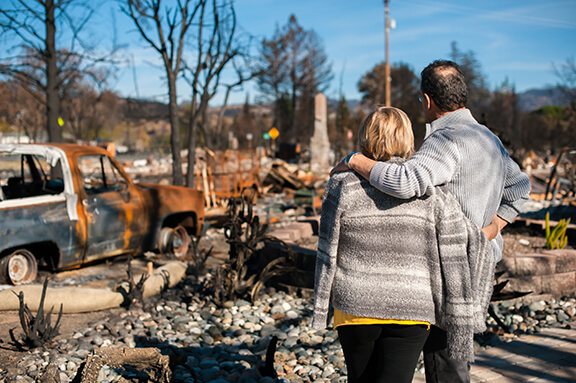Did you know that after major disasters, up to one in three survivors report symptoms consistent with psychological distress? The aftermath of these traumatic events involves not only physical rebuilding but also healing the invisible, deep-seated wounds inflicted on those affected.
May is Mental Health Awareness Month, a crucial observance that highlights the ongoing struggle many face with mental health issues and the importance of mental health solutions and well-being. This year, we spotlight the often-neglected psychological impact of disasters to create a better understanding of these impacts and foster community resilience and recovery.
The Psychological Toll of Disasters

Disasters, whether natural or man-made, present numerous challenges beyond immediate physical destruction. These catastrophic events have an enduring effect on mental health, with repercussions that ripple through disaster-impacted populations:
- Post-Traumatic Stress Disorder (PTSD): Triggered by witnessing or experiencing traumatic events, PTSD symptoms include flashbacks, nightmares, severe anxiety, and uncontrollable thoughts about the event. Research indicates that the prevalence of PTSD among directly impacted populations can range from 30% to 40% in the year following a disaster.
- Anxiety and Depression: Common responses among disaster survivors include persistent sadness, hopelessness, and elevated anxiety levels, often persisting for years. Studies show that rates of depression and anxiety are typically elevated in disaster-impacted populations, affecting 20% to 30% of individuals.
- Substance Abuse: Many people affected by disasters turn to increased substance use or misuse as a coping mechanism, which can exacerbate existing mental health conditions or lead to new health and social issues.
- Chronic Stress: The stress stemming from loss, displacement, and the disruption of everyday life can lead to chronic stress, which impacts long-term health.
Statistical Overview of Mental Health Post-Disasters

The prevalence of mental health conditions in post-disaster settings significantly exceeds that of unaffected populations. The World Health Organization (WHO) reports that approximately one in five people in post-disaster environments will experience depression, anxiety, PTSD, bipolar disorder, or schizophrenia. Moreover, the impact on children and adolescents is particularly alarming; up to 50% of young people exposed to disasters may exhibit PTSD symptoms. This is compounded by disruptions to social services, education, and family stability, which exacerbate the mental health crisis among younger populations. The Lancet’s studies further reveal that the risk of long-term psychiatric disorders doubles following a disaster. The persistence of these conditions, alongside the typically insufficient mental health resources in disaster-struck areas, underscores the critical need for comprehensive mental health care strategies within emergency management frameworks.
Case Studies on Disaster Impact
Case Study 1: Hurricane Katrina, 2005
Hurricane Katrina remains one of the deadliest hurricanes in U.S. history, devastating the Gulf Coast with overwhelming physical destruction and widespread flooding. The psychological aftermath was equally severe, with a significant impact on mental health. A study conducted by the Columbia University Mailman School of Public Health1 found that two years after the hurricane, the prevalence of PTSD among directly affected populations was approximately 21%, while 54% of the population reported experiencing some form of depression. Many survivors faced long-term displacement, which exacerbated mental health issues due to prolonged stress and instability. The lack of immediate and accessible mental health services further hindered recovery efforts and prolonged suffering.
Five years after Hurricane Katrina, Columbia University researchers revisited the long-term impacts2, focusing particularly on children and adolescents. Their findings revealed that one-third of the child survivors were diagnosed with mental health disorders. However, less than half of these children had access to the necessary professional mental health services. Moreover, the study highlighted a stark disparity, showing that children affected by the disaster were 4.5 times more likely to suffer from serious emotional disturbances compared to their unaffected peers.
Case Study 2: Fukushima Daiichi Nuclear Disaster, 2011
The Fukushima Daiichi nuclear disaster resulted in significant psychological distress among the Japanese population, particularly among evacuees who faced sudden and indefinite displacement. According to a report from Fukushima Medical University3, the rates of psychological distress among evacuees remained high years after the disaster, with approximately 20% reporting severe psychological distress. The ongoing fear of radiation exposure and the social stigma attached to being an evacuee compounded the mental health challenges. The prevalence of PTSD was estimated to be around 14.6% among evacuees, which is significantly higher compared to the general population. Long-term mental health monitoring and support were recommended by several studies to address the persistent impacts.
The catastrophic impacts of Hurricane Katrina and the Fukushima Daiichi nuclear disaster illustrate the profound psychological toll disasters can inflict on affected populations. These case studies underscore the critical need for incorporating mental health considerations into comprehensive disaster preparedness and response frameworks. By establishing robust mechanisms to address psychological well-being, communities can ensure a more resilient and sustainable recovery process.
Mental Health Solutions for Victims of Disasters
Addressing the psychological impact of disasters requires a multifaceted approach, including the following:
- Prioritize Mental Health in Emergency Plans: Integrate mental health strategies into all disaster planning and response phases to ensure psychological support systems are in place well before disasters strike.
- Invest in Training: Provide mental health first aid training for all first responders and support staff, equipping them to effectively recognize and address signs of mental distress.
- Foster Partnerships: Build strong collaborations with local mental health organizations, community groups, and healthcare providers to enhance the accessibility and effectiveness of mental health services during crises.
- Launch Public Awareness Campaigns: Promote awareness about the mental health impacts of disasters through targeted community outreach and education, helping to reduce stigma and encourage affected individuals to seek necessary support.
- Ensure Long-Term Support: Develop long-term mental health care plans for disaster recovery to ensure that affected individuals continue receiving the mental support they need.
The psychological impacts of disasters are profound and far-reaching. They affect entire communities and last long after the physical cleanup and recovery. By understanding and addressing the mental health needs of disaster-impacted populations, communities can build stronger, more resilient foundations and integrate mental health support into planning and response efforts.
Sources:
- 1. Kessler, R. C., Galea, S., Jones, R. T., & Parker, H. A. (2006). Mental illness and suicidality after Hurricane Katrina. Bulletin of the World Health Organization, 84(12), 930-939.
- 2. Journal of Disaster Medicine and Public Health Preparedness, (2010).
- 3. Maeda, M., & Oe, M. (2017). Mental Health Consequences and Social Issues After the Fukushima Disaster. *Asia Pacific Journal of Public Health*, 29(2_suppl), 36S-46S.



